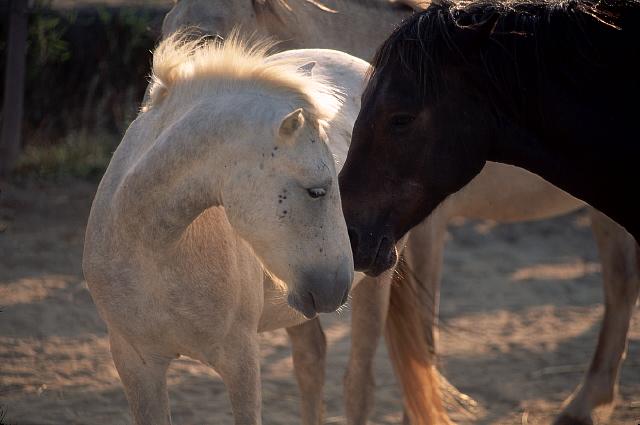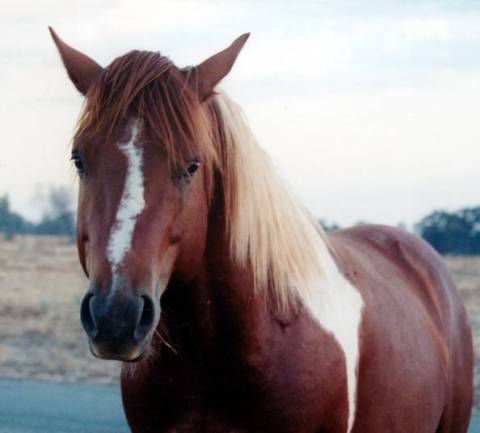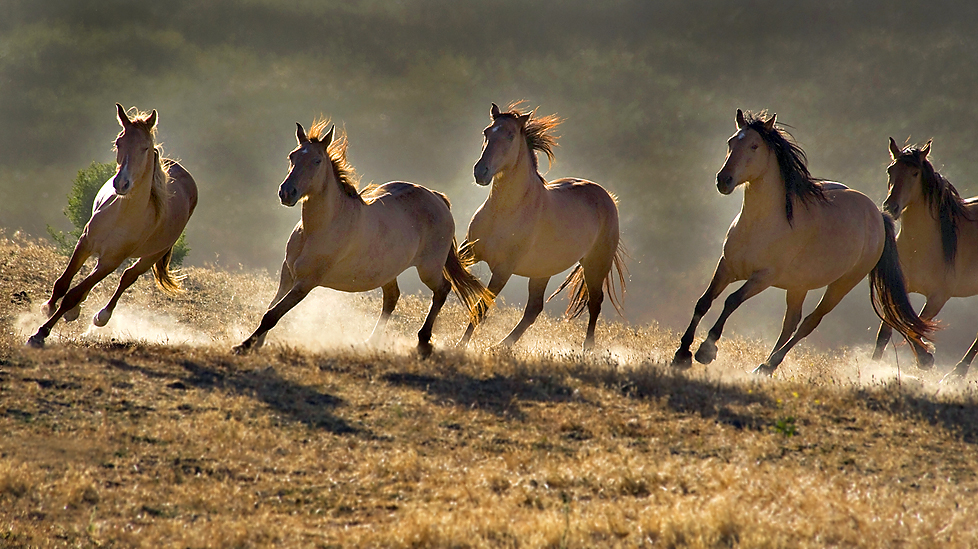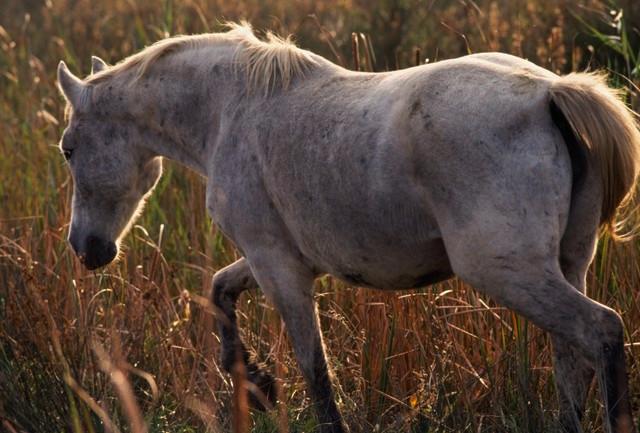Home | Favorites|The Nature of Horses|Picture Gallery | Horse Training | Horse Whisperer | Wild Horses and Burros | Animal Abuse & Neglect | Spirit | War Horse | The Black Stallion | Flicka
Wild Horses and Burros
Wild-Horses: Exposing the Myths
 1.) MYTH: Removed horses and burros are adopted to loving homes through the government’s “Adopt a Horse or Burro Program.”
1.) MYTH: Removed horses and burros are adopted to loving homes through the government’s “Adopt a Horse or Burro Program.”
FACT: While the BLM has an obligation to ensure that the persons adopting wild horses and burros are “qualified” adopters, many people do not fully understand the responsibility and commitment that are required to care for an adopted animal, thus setting the stage for failed adoptions. Rigorous screening of potential adopters, education and monitoring are critical to the success of any adoption. Sadly, the BLM has failed in all of these areas. In 1997, the Associated Press uncovered enormous and egregious abuse within the adoption program, including the revelation that many individuals were adopting large numbers of wild horses only to turn around and make sizable profits by selling them for slaughter. To make matters worse, The New York Times reported on a Justice Department investigation that revealed that BLM had a “don’t ask, don’t tell” policy on this issue, and that in fact many employees were well aware that adopters intended to sell horses for slaughter after receiving title. Only after being sued by wild horse advocates did the BLM agree to adopt measures to stem the tide of horses going to slaughter, but even then, countless horses fell through the cracks. 
Of immediate concern is an amendment to the WFHBA that was slipped into the Interior Appropriations bill in the last Congressional session, requiring horses 10 years-of-age or older or those who have not been adopted after three attempts to be sold at auction without limitation. Such “sale authority” will open the floodgates of wild horses being sold to slaughter for profit. More than 8,000 wild horses may immediately wind up on the dinner plates in fancy overseas restaurants, and countless more will follow unless legislation is swiftly enacted to repeal this ill-conceived amendment. H.R. 1018, introduced by Congressman Nick Rahall (D-WV) and Congressman Ed Whitfield (R-KY) in the House of Representatives to restore the slaughter prohibition for wild horses and burros. H.R. 503, the Prevention of Equine Cruelty Act, reintroduced by House Judiciary Committee Chairman John Conyers (D-MI) and Representative Dan Burton (R-IN) and in the Senate by Senator Mary Landrieu (D-LA) and veterinarian and Senator John Ensign (R-NV) as S. 727 will ensure that no horse meets this appalling fate.
The 1971 Wild Free-Roaming Horses and Burros Act and its legislative history make it clear that Congress, with overwhelming public support, intended for wild horses and burros to be protected in the wild, and removed only when necessary, and if removed, guaranteed humane treatment. They were never to be sold for slaughter.
 2.) MYTH: Wild horses and burros are destructive to the environment and must be removed in order to protect ecosystem health.
2.) MYTH: Wild horses and burros are destructive to the environment and must be removed in order to protect ecosystem health.
FACT: Wild horses and burros, like any wildlife species, have an impact on the environment, but due to their natural behavior, their impact is minimal. In fact, wild horses and burros play a beneficial ecological role, for example, by dispersing seeds through elimination, thereby helping to reseed the landscape. They also blaze trails during heavy snowfall and break ice at watering holes, helping weaker animals to survive during harsh winter months. Wild horses and burros can also serve as food for predator species such as mountain lions.
That said, if BLM and FS officials would have the public believe that they are genuinely concerned about ecosystem health, then they must refrain from conducting business as usual -- viz., turning a blind eye to the indisputably overriding cause of habitat degradation: livestock grazing and public encroachment. For years, the agencies have permitted extremely high levels of livestock use on public lands, resulting in soil erosion, water contamination and depletion, as well as deterioration of vegetation. While wild horses and burros may be blamed for these problems, the agencies’ own data indicate otherwise. Little has changed since the release of the 1990 U.S. General Accounting Office Report, Improvements Needed in Federal Wild Horse Program, which concluded “… the primary cause of the degradation in rangeland resources is poorly managed domestic (primarily cattle and sheep) livestock.” Unlike cattle who tend to congregate and settle in riparian areas, wild horses and burros are highly mobile, typically visiting watering areas for only short periods of time. To make matters worse, livestock are concentrated in grazing allotments at artificially high densities during the critical growing season when vegetation is extremely vulnerable to permanent damage. This overgrazing sets the stage for habitat degradation that may not be immediately apparent, but can cumulatively cause massive vegetation die off.
 3.) MYTH: Wild horses and burros must be rounded up to save them from dying of starvation or thirst.
3.) MYTH: Wild horses and burros must be rounded up to save them from dying of starvation or thirst.
FACT: While the BLM argues that wild horses and burros are being rounded up for their own good to keep them from dying of starvation or dehydration in areas affected by fire and drought throughout the West, animal advocates have frequently found that herd areas stricken by so-called “emergency conditions” weren’t nearly as bad off as the BLM claimed. Not only were wild horses and burros doing just fine, but livestock often remained in the same areas or were returned to the areas in short order. Of course, once the wild horses and burros are gone, they are gone for good – moving in the direction of achieving the overall objective of drastically reducing populations as quickly as possible. By attempting to justify extra removals as “emergencies,” the BLM is able to tap into emergency funds from other programs and go over and above their allocated budgets to meet this goal.
Tragically, many wild horse and burro herds suffer needlessly due to the fact that they have been unable to roam freely throughout their entire herd areas because of fences and other impediments that have been constructed to accommodate livestock. Hence, they are unable to access forage and water to which they are legally entitled. Wild horses and burros have survived droughts and fires in the past and will survive them in the future, just as do other wild animals, if they are treated as wild animals and left alone.
**Information resource: http://wildhorsewarriors.blogspot.com**
 1.) MYTH: Removed horses and burros are adopted to loving homes through the government’s “Adopt a Horse or Burro Program.”
1.) MYTH: Removed horses and burros are adopted to loving homes through the government’s “Adopt a Horse or Burro Program.”
 2.) MYTH: Wild horses and burros are destructive to the environment and must be removed in order to protect ecosystem health.
2.) MYTH: Wild horses and burros are destructive to the environment and must be removed in order to protect ecosystem health.  3.) MYTH: Wild horses and burros must be rounded up to save them from dying of starvation or thirst.
3.) MYTH: Wild horses and burros must be rounded up to save them from dying of starvation or thirst. 